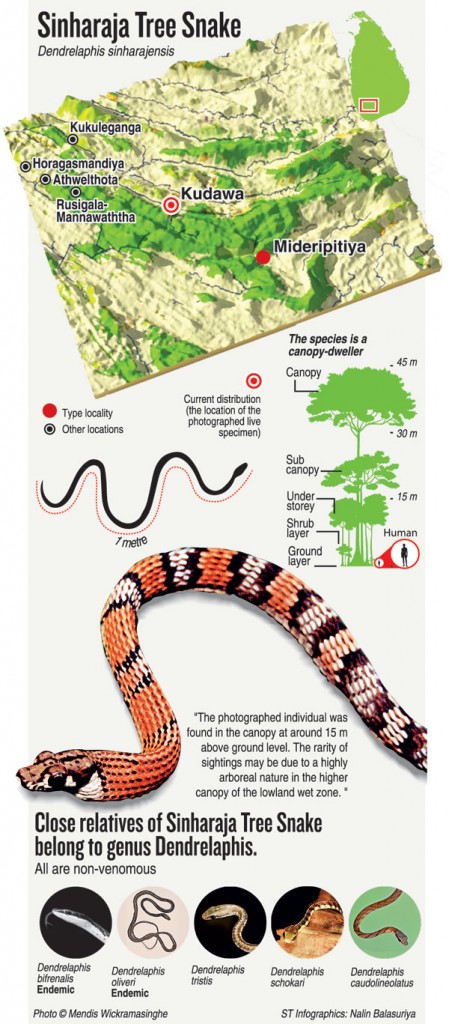News
Sinharaja’s slithering new beauty
 A new creature has been found in the Sinharaja rainforest, surprising experts who believed the well-researched forest had few secrets left.
A new creature has been found in the Sinharaja rainforest, surprising experts who believed the well-researched forest had few secrets left.
Hidden from sight high in the tree canopy is a new and vividly-coloured snake now revealed by veteran herpetologist Mendis Wickramasinghe in an article published this week in the prestigious science journal, Zootaxa.
“The snake lives in the canopy of the forest and that could be the reason it eludes the eyes of researchers who frequent Sinharaja,” Mr. Wickramasinghe explained. He had first seen the snake as early as 2001 while conducting other research and had continued to search for this snake afterwards, managing to spot just six such specimens.
He has named the new snake the Sinharaja tree snake or Sinharaja bronze-backed snake.
The Sinharaja tree snake is a beautiful reptile with a unique colour pattern of prominent cross-bars in black and white and a red neck. It has a dark purple tongue. It has a slender body, rounded pupils, enlarged vertebral scales, and a head distinct from the body.
The live specimen Mr. Wickremasinghe photographed was recorded 15m high up in trees near Kudawa. “I was on top of a small cliff so the tree canopy was at eye level when I spotted the beauty,” he said, recalling his chance encounter.
The snake is active during the day and lives in the trees. Its large pupils give it very good eyesight, and Mr. Wickremasinghe believes sight, more than scent, is used to hunt prey. The snake could be feeding on geckos, lizards, skinks and could be laying its eggs in tree hollows.
The holotype or the single type specimen upon which the scientific description and name of a new species is based was unfortunately a member of the species run over on the road near Mederipitiya. Mr. Wickramasinghe preserved it in formalin and then began the painful scientific process of comparing it with specimens of other snakes to make sure it was not, in fact, already known to science.
Mr. Wickremasinghe assigned the snake to the genus Dendrelaphis and gave it the scientific name Dendrelaphis sinharajensis. In Sinhala, it is called Sinharaja haldanda and in Tamil, Sinharaja komberi.
The Dendrelaphis genus has 44 members around the world. There are six bronze-backed snakes in the country, three of them endemic. Although they share many common features, the colour pattern of Sinharaja tree snake makes it easily distinguishable from its close relatives.
The Sinharaja tree snake is rarely sighted, so it is likely to be rare, Mr. Wickramasinghe said, stressing the need for more research into the species.
Habitat loss and forest fragmentation could affect this species directly as it need trees to survive. But, sadly, the axe of destruction moves at the boundaries of the Sinharaja forest.
With the new discovery, Mendis Wickremasinghe has scientifically described 23 new species – two snakes, 11 amphibians, seven geckos and three skinks. He hinted that another discovery is on the way, so keep checking The Sunday Times for another new species very soon.

| Award-winning book Mendis Wickramasinghe is an outstanding wildlife photographer and his maiden coffee-table book, Repertoire, won two awards at the recently-concluded State Literary Awards, commended for presenting scientific information in a simple manner and for Kasun Pradeepa’s excellent layout. Those interested in buying a copy should contact 0767 987 688 or purchase the book at a special rate from book fair stall no: L-379 of the Wildlife Trust. |

